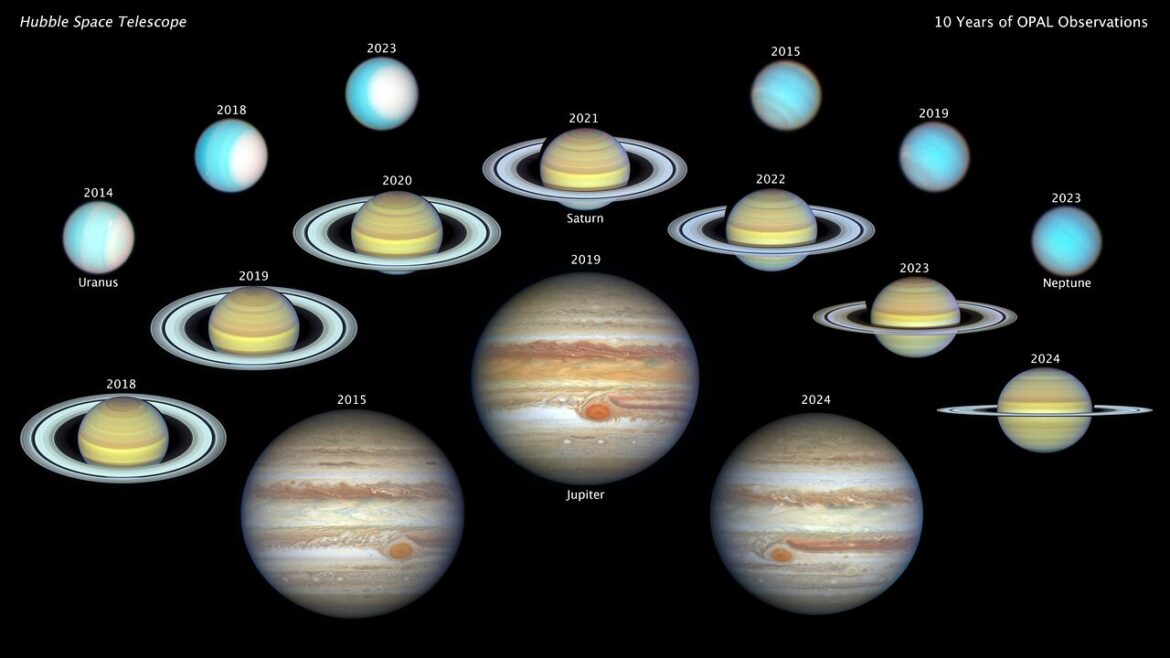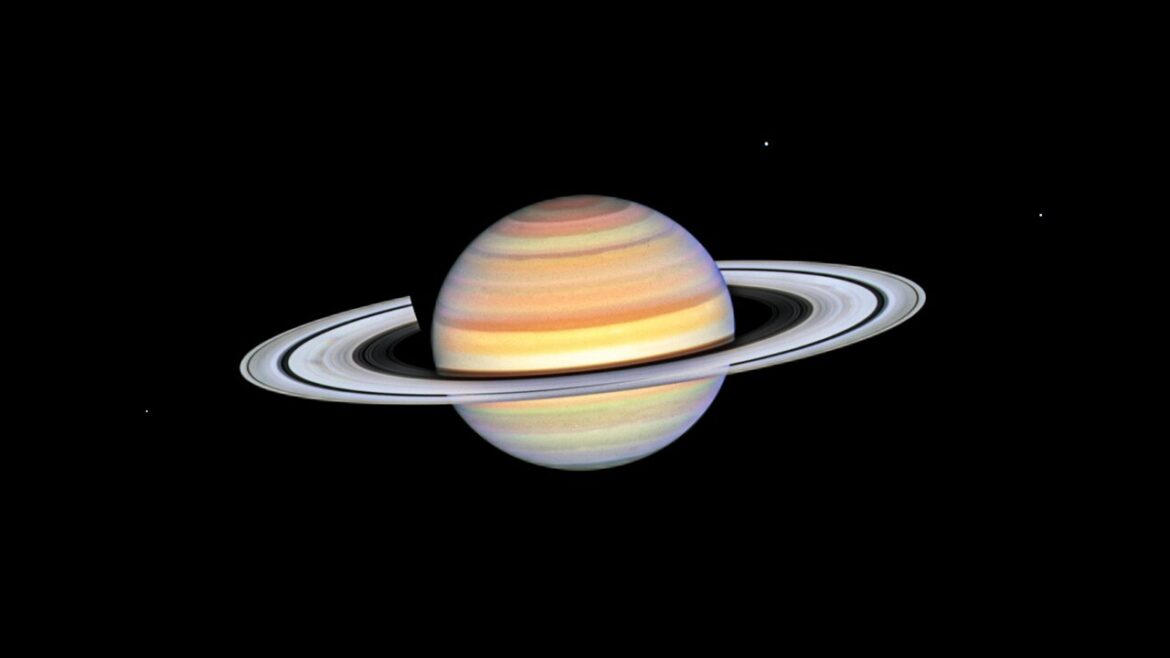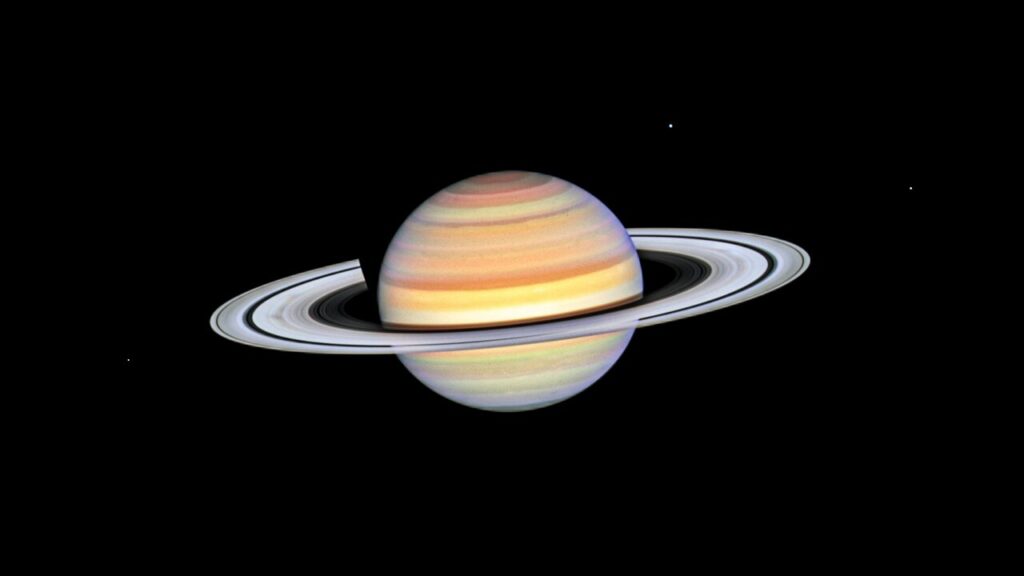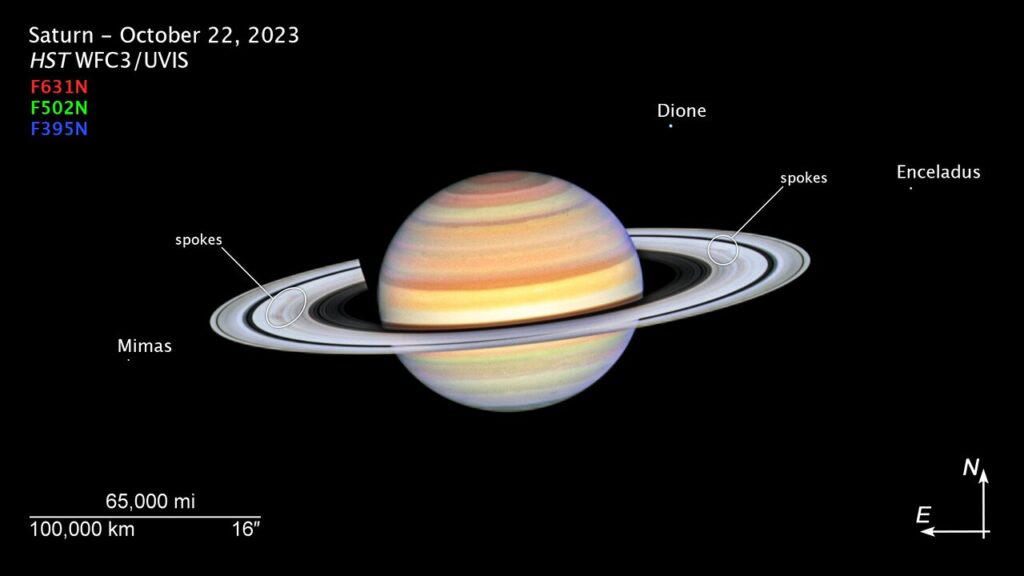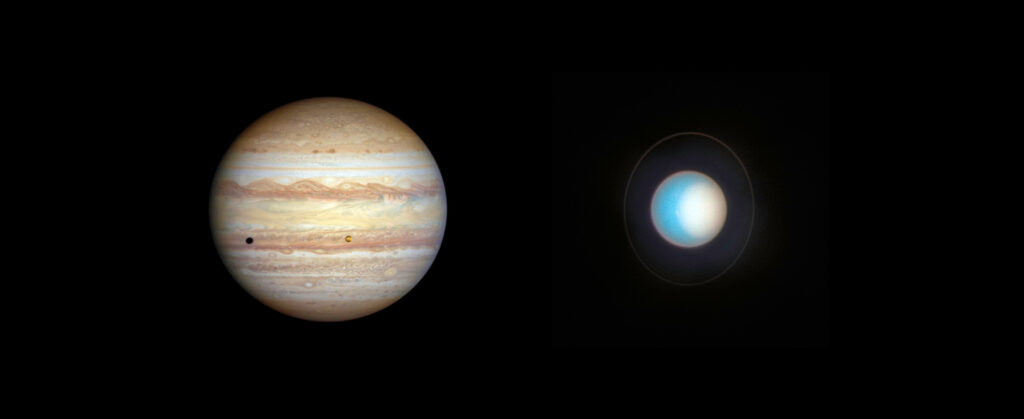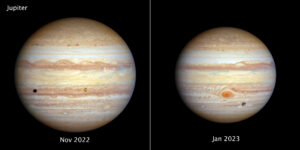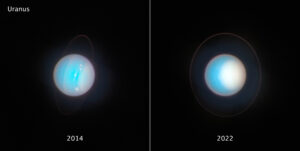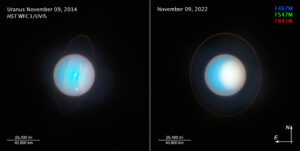Hubble celebrates a decade of tracking the outer planets
From 2014 to 2024, the NASA/ESA Hubble Space Telescope has been studying the outer planets under a program called OPAL (Outer Planet Atmospheres Legacy) to obtain long-time baseline observations of Jupiter, Saturn, Uranus, and Neptune in order to understand their atmospheric dynamics and evolution. Hubble is the only telescope that can provide high spatial resolution and image stability for global studies of cloud coloration, activity, and atmospheric motion on a consistent time basis to help constrain the underlying mechanics of weather and climate systems.
All four of the outer planets have deep atmospheres and no solid surfaces. Their churning atmospheres have their own unique weather systems, some with colorful bands of multicolored clouds, and with mysterious, large storms that pop up or linger for many years. Each also has seasons lasting many years as they revolve around the Sun.
Following the complex behavior is akin to understanding Earth’s dynamic weather as followed over many years, as well as the Sun’s influence on the solar system’s weather. The four wonder-worlds also serve as proxies for understanding the weather and climate on similar planets orbiting other stars.
Planetary scientists realized that any one year of data from Hubble, while interesting in its own right, doesn’t tell you the full story on the outer planets. Hubble’s OPAL program has routinely visited the planets once a year when they are closest to the Earth, an alignment called opposition. This has yielded a huge archive of data that has led to a string of remarkable discoveries to share with planetary astronomers around the world.
Highlights of the OPAL team’s decade of discovery is provided below.
Jupiter
Jupiter’s bands of clouds present an ever-changing kaleidoscope of shapes and colors. There is always stormy weather on Jupiter: cyclones, anticyclones, wind shear, and the largest storm in the solar system, the Great Red Spot (GRS). Jupiter is covered with largely ammonia ice-crystal clouds on top of an atmosphere that’s tens of thousands of miles deep.
Hubble’s sharp images track clouds and measure the winds, storms, and vortices, in addition to monitoring the size, shape and behavior of the GRS. Hubble follows as the GRS continues shrinking in size, but is still large enough to swallow Earth. OPAL data recently measured how often mysterious dark ovals—visible only at ultraviolet wavelengths—appeared in the “polar hoods” of stratospheric haze. Unlike Earth, Jupiter is only inclined three degrees on its axis (Earth is 23.5 degrees). Seasonal changes might not be expected, except that Jupiter’s distance from the Sun varies by roughly 64 million kilometres over its 12-year-long orbit, and so OPAL closely monitors the atmosphere for seasonal effects. Another Hubble advantage is that ground-based observatories can’t continuously view Jupiter for two Jupiter rotations, because that adds up to 20 hours. During that time, an observatory on the ground would have gone into daytime and Jupiter would no longer be visible until the next evening.

Credit: NASA, ESA, A. Simon (NASA/GSFC), M. Wong (UC Berkeley), J. DePasquale (STScI)
OPAL’s findings may also support ESA’s Jupiter Icy Moons Explorer, Juice, which was launched on 14 April 2023. Juice will make detailed observations of Jupiter and its three large ocean-bearing moons — Ganymede, Callisto and Europa — with a suite of remote sensing, geophysical and in situ instruments. The mission will characterise these moons as both planetary objects and possible habitats, explore Jupiter’s complex environment in depth, and study the wider Jupiter system as an archetype for gas giants across the Universe.

Credit:
NASA, ESA, A. Simon (GSFC), M. Wong (UC Berkeley), J. DePasquale (STScI)
Saturn
Saturn takes more than 29 years to orbit the Sun, and so OPAL has followed it for approximately one quarter of a Saturnian year (picking up in 2018, after the end of the Cassini mission). Because Saturn is tilted 26.7 degrees, it goes through more profound seasonal changes than Jupiter. Saturnian seasons last approximately seven years. This also means Hubble can view the spectacular ring system from an oblique angle of almost 30 degrees to see the rings tilted edge-on. Edge-on, the rings nearly vanish because they are relatively paper-thin. This will happen again in 2025.
OPAL has followed changes in colors of Saturn’s atmosphere. The varying color was first detected by the Cassini orbiter, but Hubble provides a longer baseline. Hubble revealed slight changes from year-to-year in color, possibly caused by cloud height and winds. The observed changes are subtle because OPAL has covered only a fraction of a Saturnian year. Major changes happen when Saturn progresses into the next season.
Saturn’s mysteriously dark ring spokes, which slice across the ring plane, are transient features that rotate along with the rings. Their ghostly appearance only persists for two or three rotations around Saturn. During active periods, freshly formed spokes continuously add to the pattern. They were first seen in 1981 by Voyager 2. Cassini also saw the spokes during its 13-year-long mission, which ended in 2017. Hubble shows that the frequency of spoke apparitions is seasonally driven, first appearing in OPAL data in 2021. Long-term monitoring shows that both the number and contrast of the spokes vary with Saturn’s seasons.

Credit: NASA, ESA, A. Simon (NASA/GSFC), M. Wong (UC Berkeley), J. DePasquale (STScI)
Uranus
Uranus is tilted on its side so that its spin axis almost lies in the plane of the planet’s orbit. This results in the planet going through radical seasonal changes along its 84-year-long trek around the Sun. The consequence of the planet’s tilt means part of one hemisphere is completely without sunlight, for stretches of time lasting up to 42 years. OPAL has followed the northern pole now tipping toward the Sun.
With OPAL, Hubble first imaged Uranus after the spring equinox, when the Sun was last shining directly over the planet’s equator. Hubble resolved multiple storms with methane ice-crystal clouds appearing at mid-northern latitudes as summer approaches the north pole. Uranus’ north pole now has a thickened photochemical haze with several little storms near the edge of the boundary. Hubble has been tracking the size of the north polar cap and it continues to get brighter year after year. As the northern summer solstice approaches in 2028, the cap may grow brighter still, and will be aimed directly toward Earth, allowing good views of the rings and north pole. The ring system will then appear face-on.
Neptune
When Voyager 2 flew by Neptune 1989, astronomers were mystified by a great dark spot the size of the Atlantic Ocean looming in the atmosphere. Was it long-lived like Jupiter’s Great Red Spot? The question remained unanswered until Hubble was able to show in 1994 that such dark storms were transitory, cropping up and then disappearing over a duration of two to six years each. During the OPAL program, Hubble saw the end of one dark spot and the full life cycle of a second one – both of them migrating toward the equator before dissipating. The OPAL program ensures that astronomers won’t miss another one.
Hubble observations uncovered a link between Neptune’s shifting cloud abundance and the 11-year solar cycle. The connection between Neptune and solar activity is surprising to planetary scientists because Neptune is our solar system’s farthest major planet. It receives sunlight with about 0.1% of the intensity Earth receives. Yet Neptune’s global cloudy weather seems to be influenced by solar activity. Do the planet’s four seasons (each lasting approximately 40 years) also play a role? We may find out, if the OPAL program continues running on Hubble until the year 2179!

From upper-left toward center, the hazy white polar cap on the three teal-colored Uranus images appears more face-on as the planet approaches northern summer.
From center-right to far-center right, three images of the blue planet Neptune show the coming and going of clouds as the Sun’s radiation level changes. Several of Neptune’s mysterious dark spots have come and gone sequentially over OPAL’s decade of observations.
Seven views of yellow-brown Saturn stretch across the center of the mosaic in a triangle—one for each year of OPAL observations—showing the tilt of the angle of the ring plane relative to the view from Earth. Approximately every 15 years the relatively paper-thin rings (about one mile thick) can be seen edge-on. In 2018 they were near their maximum tilt toward Earth. Colorful changes in Saturn’s bands of clouds can be followed as the weather changes.
At bottom center, three images of Jupiter spanning nearly a decade, form a triangle. There are notable changes in Jupiter’s banded cloud structure of zones and belts. OPAL measured shrinking of the legendary Great Red Spot, while its rotation period speeds up.
Credit: NASA, ESA, A. Simon (NASA-GSFC), M. H. Wong (UC Berkeley), J. DePasquale (STScI)
Press release from ESA Hubble.




